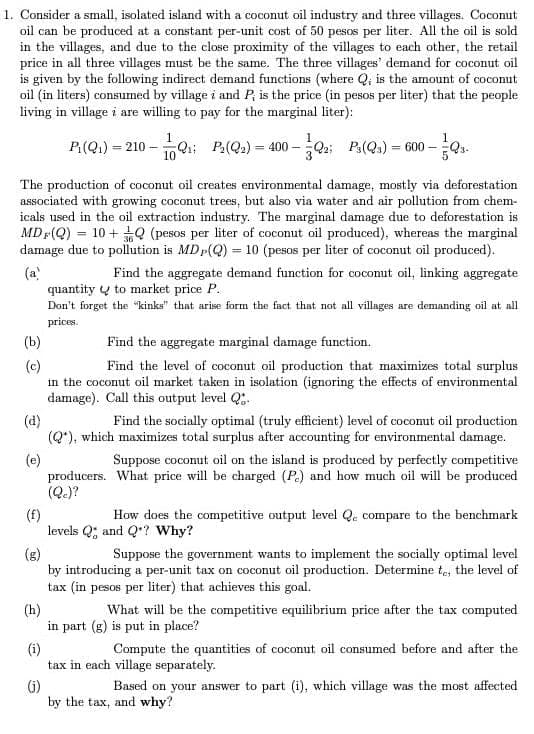(a' quantity y to market price P. Find the aggregate demand function for coconut oil, linking aggregate Don't forget the "kinks" that arise form the fact that not all villages are demanding oil at all prices. (b) Find the aggregate marginal damage function. (c) in the coconut oil market taken in isolation (ignoring the effects of environmental damage). Call this output level Q;. Find the level of coconut oil production that maximizes total surplus
(a' quantity y to market price P. Find the aggregate demand function for coconut oil, linking aggregate Don't forget the "kinks" that arise form the fact that not all villages are demanding oil at all prices. (b) Find the aggregate marginal damage function. (c) in the coconut oil market taken in isolation (ignoring the effects of environmental damage). Call this output level Q;. Find the level of coconut oil production that maximizes total surplus
Chapter1: Making Economics Decisions
Section: Chapter Questions
Problem 1QTC
Related questions
Question

Transcribed Image Text:1. Consider a small, isolated island with a coconut oil industry and three villages. Coconut
oil can be produced at a constant per-unit cost of 50 pesos per liter. All the oil is sold
in the villages, and due to the close proximity of the villages to each other, the retail
price in all three villages must be the same. The three villages' demand for coconut oil
is given by the following indirect demand functions (where Q, is the amount of coconut
oil (in liters) consumed by village i and P, is the price (in pesos per liter) that the people
living in village i are willing to pay for the marginal liter):
P(Q1) = 210
·유Q; P(Qa)-400
Q2: P(Qa) = 600 –
The production of coconut oil creates environmental damage, mostly via deforestation
associated with growing coconut trees, but also via water and air pollution from chem-
icals used in the oil extraction industry. The marginal damage due to deforestation is
MDF(Q) = 10 + +Q (pesos per liter of coconut oil produced), whereas the marginal
damage due to pollution is MDp(Q) = 10 (pesos per liter of coconut oil produced).
(a'
quantity ų to market price P.
Don't forget the "kinks" that arise form the fact that not all villages are demanding oil at all
prices.
Find the aggregate demand function for coconut oil, linking aggregate
(b)
Find the aggregate marginal damage function.
(c)
in the coconut oil market taken in isolation (ignoring the effects of environmental
damage). Call this output level Q.
Find the level of coconut oil production that maximizes total surplus
(d)
(Q*), which maximizes total surplus after accounting for environmental damage.
Find the socially optimal (truly efficient) level of coconut oil production
(e)
producers. What price will be charged (P.) and how much oil will be produced
(Q.)?
Suppose coconut oil on the island is produced by perfectly competitive
(f)
levels Q; and Q? Why?
How does the competitive output level Q. compare to the benchmark
(g)
by introducing a per-unit tax on coconut oil production. Determine te, the level of
tax (in pesos per liter) that achieves this goal.
Suppose the government wants to implement the socially optimal level
(h)
in part (g) is put in place?
What will be the competitive equilibrium price after the tax computed
(i)
tax in each village separately.
Compute the quantities of coconut oil consumed before and after the
(i)
by the tax, and why?
Based on your answer to part (i), which village was the most affected
Expert Solution
This question has been solved!
Explore an expertly crafted, step-by-step solution for a thorough understanding of key concepts.
This is a popular solution!
Trending now
This is a popular solution!
Step by step
Solved in 3 steps

Knowledge Booster
Learn more about
Need a deep-dive on the concept behind this application? Look no further. Learn more about this topic, economics and related others by exploring similar questions and additional content below.Recommended textbooks for you


Principles of Economics (12th Edition)
Economics
ISBN:
9780134078779
Author:
Karl E. Case, Ray C. Fair, Sharon E. Oster
Publisher:
PEARSON

Engineering Economy (17th Edition)
Economics
ISBN:
9780134870069
Author:
William G. Sullivan, Elin M. Wicks, C. Patrick Koelling
Publisher:
PEARSON


Principles of Economics (12th Edition)
Economics
ISBN:
9780134078779
Author:
Karl E. Case, Ray C. Fair, Sharon E. Oster
Publisher:
PEARSON

Engineering Economy (17th Edition)
Economics
ISBN:
9780134870069
Author:
William G. Sullivan, Elin M. Wicks, C. Patrick Koelling
Publisher:
PEARSON

Principles of Economics (MindTap Course List)
Economics
ISBN:
9781305585126
Author:
N. Gregory Mankiw
Publisher:
Cengage Learning

Managerial Economics: A Problem Solving Approach
Economics
ISBN:
9781337106665
Author:
Luke M. Froeb, Brian T. McCann, Michael R. Ward, Mike Shor
Publisher:
Cengage Learning

Managerial Economics & Business Strategy (Mcgraw-…
Economics
ISBN:
9781259290619
Author:
Michael Baye, Jeff Prince
Publisher:
McGraw-Hill Education